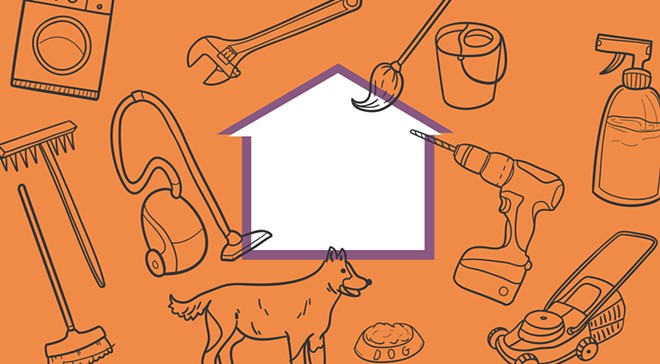Exchange of needs: A new affordable housing alternative in SLO pairs income-affected individuals with homeowners in need of help with chores
By Karen Garcia[{
"name": "Ad - Medium Rectangle CC01 - 300x250",
"id": "AdMediumRectangleCC01300x250",
"class": "inlineCenter",
"insertPoint": "8",
"component": "2963441",
"requiredCountToDisplay": "12"
},{
"name": "Ad - Medium Rectangle LC01 - 300x250",
"id": "AdMediumRectangleCC01300x250",
"class": "inlineCenter",
"insertPoint": "18",
"component": "2963441",
"requiredCountToDisplay": "22"
},{
"name": "Ad - Medium Rectangle LC09 - 300x250",
"id": "AdMediumRectangleLC09300x250",
"class": "inlineCenter",
"insertPoint": "28",
"component": "3252660",
"requiredCountToDisplay": "32"
}]
When SmartShare Housing Solutions began its HomeShare SLO program in 2017, the goal was to provide San Luis Obispo County with an alternative affordable housing option.
Through the program, homeowners with an extra bedroom are matched with a qualified tenant—shared housing seekers are required to undergo a background check, provide proof of income, and have three references—for a low rental cost.
The solution is two-fold, isolated residents who are in need of extra income or companionship are matched with an individual looking for housing at a cost that's below market rate. At the time, a rental agreement could be anywhere between $570 to $800.
The nonprofit is now establishing another alternative program to aid individuals whose income has been affected by COVID-19 via an exchange—helping around the house to reduce the tenant's rent.
SmartShare Housing Solutions Executive Director Celeste Goyer said the Reduced Rent Task Exchange Homeshare has been in the works for a long time.
"This is a program that people have been asking about, but now was the right time to fine tune it and offer it to the greater community," Goyer said.
The task exchange model is available for existing and new housing seekers with a limited budget. They can reduce their rent by providing five to 15 hours of help to the homeowner each week with tasks such as light housekeeping, pet care, rides to appointments, yard work, meal preparation, computer help, or companionship.
If the tenant completes approximately 15 hours of assistance to the homeowner per week, he or she will only pay roughly $150 of monthly utility share.
Partial task exchanges are also an option where the tenant provides either five to eight hours of assistance and pays anywhere between $300 to $500 in monthly rent.
As people get older, Goyer said—and now more than ever—they just need an extra little bit of help.
"It might not be a living situation that'll last forever, but for a few years somebody can take out the trash, change a light bulb, fix a meal, or make sure you're eating," she said.
Goyer said the nonprofit receives calls daily from people who have either lost their employment, held several jobs and are down to one, had their hours reduced, or their credit scores have dropped because they've missed a bill due to income loss.
"We've seen all of that. As you know there are very few opportunities for housing that is within reach of people at the lowest income ranges and certainly very few opportunities for people on fixed incomes like Social Security or disability," she said.
Among the calls for housing assistance, Goyer said there have been fewer calls from individuals interested in putting their home on the program.
"Those who have called us are under significant pressure financially. They rely on that rent income from their room to pay their taxes," she said.
Currently there isn't much data on the number of people in San Luis Obispo County who have been affected financially or have had their residential situation impacted by the COVID-19 pandemic. However, some local nonprofits say they have seen an increase in calls for service.
In Peoples' Self-Help Housing's 2019-20 impact report, it found that since March, the Supportive Housing Program saw requests for assistance increase by 217 percent. Through the program, team members helped residents navigate the unemployment process, secure pandemic-related benefits, access food programs, and find disaster relief assistance.
Case managers for the organization were able to identify residents with the greatest need for rental support and helped distribute $45,000 in relief assistance for more than a hundred families with funding from the SLO Community Foundation and the Santa Barbara Foundation.
During the Nov. 16 Homeless Services Oversight Council meeting, service providers throughout the county gave an update on their available services. Almost all of the organizations reported that they either filled their available housing spaces, can't take in new clients, or can't provide certain services to the community.
The Community Action Partnership of San Luis Obispo and the Good Samaritan Shelter's veterans programs, for example, exceeded the number of households they expected to serve this year.
The Housing Authority of San Luis Obispo (HASLO) stated that the economic effects of COVID-19 have significantly impacted its voucher program. Many of its clients have experienced a reduction in income due to the pandemic, so HASLO's cost per voucher has increased, which could potentially impact the organization's annual budget by $1 million. As a result, HASLO isn't issuing any new vouchers, which typically get individuals off the street and into housing.
According to the Pew Research Center, approximately 22 percent of U.S. adults have changed their residence due to the pandemic or have said they know someone who has.
The survey conducted in early June found that 3 percent of adults have moved permanently or temporarily due to COVID-19, and 6 percent of those interviewed said they had someone move into their household because of it. An additional 14 percent of adults surveyed said they didn't personally experience relocation but know someone who did.
The National Low Income Housing Coalition, along with eight other organizations and academic institutions, released a report that concluded 30 million to 40 million people in the U.S. are at risk of losing their homes in the next several months without the intervention of federal assistance.
The organizations compiled information from the U.S. Census Bureau's Household Pulse Survey, projected eviction filings, unemployment data, and housing insecurity statistics. Their findings state that without at least $100 billion in emergency rental assistance and a nationwide moratorium on evictions, millions of renters who are currently experiencing financial hardship due to the coronavirus will face displacement and homelessness on a historic scale.
Laurel Weir, the homeless services coordinator for the SLO County Department of Social Services said that the eviction moratorium helped stem the tide of evictions locally. Households that otherwise would have become homeless due to a loss of income were able to stay in their homes, although she said loss of housing is still happening on a lesser level. Δ
Reach Staff Writer Karen Garcia at [email protected].
Latest in News
Readers also liked…
-

Coast Unified teachers upset over new position's salary and qualifications
Oct 20, 2022 -

SLO police identify alleged driver who hit and killed couple
Dec 22, 2022 -

When the levee breaks: Oceano residents, county officials walk a tightrope of regulations to manage Arroyo Grande Creek, which some say led to the levee's failure in January
May 18, 2023











